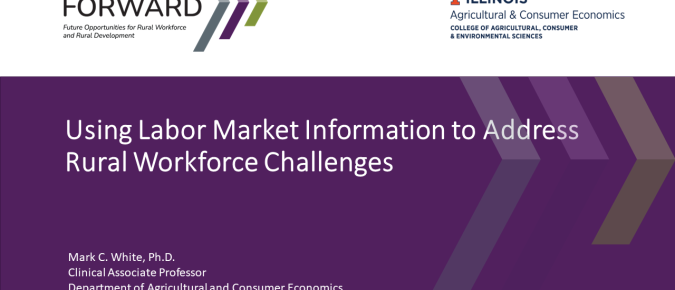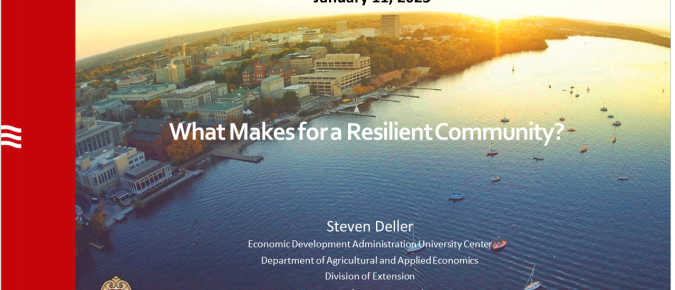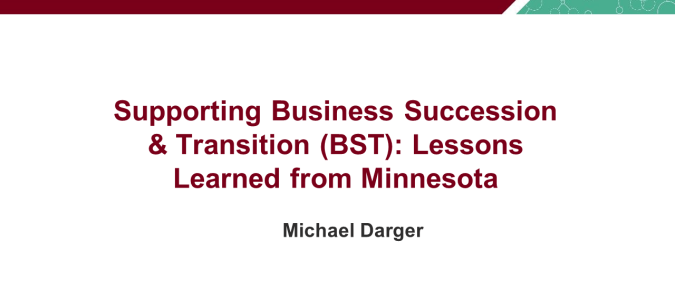The UW-Madison EDA University Center conducted a statewide survey of Wisconsin residents on broadband access and affordability, with the goal of estimating the willingness to pay for broadband. As the state makes significant investments in broadband infrastructure, attention is shifting to the willingness, or ability, of people, particularly lower income people, to pay for broadband subscriptions.
Using 2022 county sales tax data, we examine the strength and weaknesses of Wisconsin retail and service markets through the application of the tools of Trade Area Analysis.
This webinar dives into the world of rural recruitment and welcoming strategies, drawing inspiration from successful initiatives in Minnesota communities. This webinar will provide practical tools and insights that can be applied to Wisconsin communities.
This webinar highlights several rural workforce challenges and the role that university extension can play in addressing these challenges. It also introduces the Future Opportunities for Rural Workforce and Rural Development (FORWARD) curriculum designed by the North Central Regional Center for Rural Development (NCRCRD) at Purdue University and the Association of Public and Land Grant Universities (APLU)—a curriculum intended to support extension professionals in their efforts address some of these rural workforce challenges. The webinar gives particular focus on how labor market information (LMI) and other types of socio-economic data can be more effectively woven into rural workforce planning efforts.
Using the latest research and data specific to Wisconsin’s rural communities and regions, this summit focuses on the Wisconsin rural economy. The summit includes an overview of the latest economic and demographic trends across rural communities, an examination of entrepreneurship, and a discussion of what rural communities can do to foster economic growth and development.
This webinar describes work from the University of Minnesota-Extension to support business retention and expansion efforts in rural areas. With over 20 years of experience working with rural communities, MN-Extension has developed several resources that support economic development leaders to create a supportive ecosystem for rural business retention and expansion. Three guest presenters, Michael Darger, Marty Walsh, and Amy Schaefer, discuss the importance of business retention and expansion in rural communities.
One long-held strategy to foster economic growth and development is to recapture tax dollars that flow to higher units of government. Paying taxes to higher units of government, such as the state and/or federal government, is a leakage from the local economy. In a sense, these leakages are akin to a local business buying inputs from vendors outside of the community or local residents shopping outside of the community. While many communities strike to close these leakages by encouraging firms and shoppers to buy locally, such an approach does not apply to state and federal taxes. Rather, communities often strive to have those dollars returned to the community through local state and federal government spending.
As part of the 2023 Regional Economic Conditions Conference hosted by the Federal Reserve Bank of Minneapolis, Dr. Tessa Conroy provides an overview of the Wisconsin labor force.
Professor Deller addressed: Why are some communities more resilient to shocks? What can communities do to improve their ability to rebound?
Using 2021 county sales tax data, we examine the strength and weaknesses of Wisconsin retail and service markets through the application of the tools of Trade Area Analysis. Only those counties that have elected to collect the optional county sales tax are included in the analysis. Because sales tax data are used one must keep in mind that the analysis focuses only on taxable sales and may not reflect the total level of activity in the county. Using Pull Factors and measures of Surplus and Leakage the relative strengths, and weaknesses, of local retail and service markets are identified.
There are about 50,000 employer businesses owned by people over 55 years old in Minnesota. Or about 50% of the businesses in the state. In this webinar, guest presenter, Michael Darger, describes efforts at the University of Minnesota Extension to work across organizations to raise awareness among business owners and create support for business succession and transition (BST) planning in rural areas.
People of color are starting and growing businesses at high rates in Wisconsin. This study explored the experiences of BIPOC entrepreneurs in Fond du Lac County through 1-1 interviews and the Community Capitals Framework (CCF). Business owners expressed satisfaction with the natural beauty and safety of the area while describing limited technical knowledge (human capital), networks (social capital), and financial capital in the critical startup phase of their entrepreneurship. Business development technicians and educators can use this study to better support entrepreneurs of color in their Wisconsin communities.
















